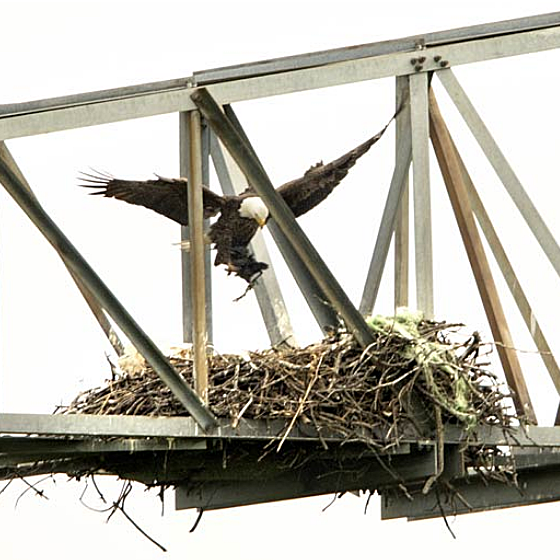1 / 22

Tower from a distance. The nest is clearly visible in the lower arm. Eagles often roost above the nest on the tower.
The black circle on the tower leg below the nest is the Internet antenna. Note: No wires!
2 / 22

The lower arm is 40 feet (12 m) long. The nest is 18 feet (5.5 m) from the tower.
The old (damaged) cameras are attached to the far left of the upper arm, and far right where the arm is attached to the tower.
3 / 22

View from under the nest. The sheet metal support extends from the left and all the way under the nest.
The white Internet microwave antenna is visible where it's bolted to a tower leg below the nest.
4 / 22

Michael (left) and Aaron of Good Faith Energy installing the fourth of six solar panels.
The old system had two much smaller panels.
5 / 22

All six solar panels installed with a "winter" tilt for maximum power production during the nesting season.
Though not apparent, the solar panel rack is six feet away from the tower on the opposite side from the nest.
6 / 22

Camera electronics. Clockwise: Sine wave inverter (black box); mic amplifier (vertical), camera interface (horizontal), audio & video combiner, and an Internet "switch". Foreground: a Midnite Classic charge controller optimizes battery charging.
7 / 22

Three 12-volt "lead-carbon" batteries provide storage for more than 14 days of cloudy weather.
These aren't "car" batteries. Together they weigh nearly 500 lbs (227 kg)!
8 / 22

David Smid (left), and John DeFillipo (Wetland Center Director) fabricate the camera bracket on site.
The old bracket wasn't suitable for the new camera location.
9 / 22

Crane crew (facing the camera), John DeFillipo (left), and Michael Solano (right) prepare for the tower work.
Step 1: Remove the old cameras located up 100 feet (30.5 m), at the top of the tower.
10 / 22

Crane ride to the top. John DeFillipo (left) and the crane operator give perspective to the size of the nest.
Estimates today place the nest weight in the 2020-2021 nesting season around 600 lbs (272.2 kg).
11 / 22

Old camera #1 being removed from the upper tower arm. Camera #2 (right) soon followed.
Remember, this work is being done 100 feet above the ground!
12 / 22

New camera attached to the tower on the fabricated bracket. Strong winds cause the camera to shake at times.
The camera is inside the protective dome. It pans (rotates) 360°, and tilts. The eagles don't see it or hear it move.
13 / 22

Microphone being attached to an arm brace by Michael Solano (left) and Aaron Bell (right) of Good Faith Energy.
The new camera is attached to the main tower structure at the top of the arm.
14 / 22

This is the "EMT" ("conduit" to most people) supporting the microphone. Note the attention to the ground wires.
To help reduce the possibility of lightning damage, everything was solidly grounded, as visible here.
15 / 22

Microphone from the "front". This is a view we can't see from the camera (background).
Stainless steel straps and heavy-duty clamps hold the mic to the tower.
16 / 22

This microwave antenna links the Eagle Cam system to the Wetland Center headquarters, and ultimately to the Internet.
Though the system uses a fairly high power transmitter, weather can still reduce the signal, resulting in "buffering".
17 / 22

David Smid (Information Technology guru) gives the eagle cam system its first test. Results: SUCCESS!
A few tweaks were needed to optimize system performance. The system went online on October 6, 2020.
18 / 22

With everything operational, John DeFillipo (left), Michael Solano (right), and Katherine (system benefactor)
team up to close the weatherproof box with the electronics inside.
19 / 22

The honor of closing the final latch on the electronics box was given to Katherine.
Locks were installed to reduce the chance of tampering.
20 / 22

The "Team". Left to Right: Aaron Bell (Good Faith Energy). David Smid (IT guru). Michael Solano (Good Faith Energy).
John DeFillipo (Wetland Center Director), and Katherine (seated).
21 / 22

With success of the new Eagle Cam, Katherine - seeing her dream realized - was briefly overcome with emotion,
and was comforted by John DeFillipo, Center Director.
22 / 22

The team behind the new eagle cam:
John DeFillipo, Director, John Bunker Sands Wetland Center
Dan Lepinski, P.E. (North Texas Renewable Energy Engineering), System Designer
Good Faith Energy, System Assembly & Installation
David Smid (Mica Steelworks), Information Technology Guru
Primoris, Crane Provider and Crane Operators
... and most of all .. Katherine D., whose generous donation made the system possible.
❮
❯























